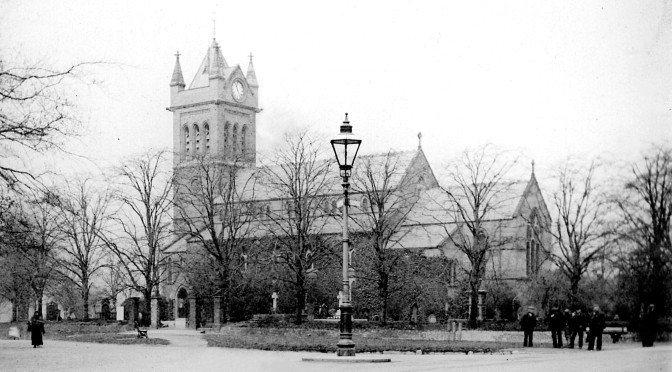
It is not generally known that Bloxwich possesses one of the oldest and most complete monuments in the Midlands – although it is of two different periods – and it is certainly the oldest thing in Bloxwich.
The old preaching cross or column standing in All Saints churchyard, on the south side close to the church itself, has been an object of curiosity to generations of parishioners. We may safely designate it as a cross, since by no means all old crosses conformed to the true cruciform shape. But this cross is far older than the church itself, being probably the oldest monument in the borough, and is very important.
Throughout the Middle Ages, Bloxwich was a small agricultural village with a population of around 600. A Chapel of Ease to Walsall Parish Church was licensed for services at Bloxwich in 1413, but Bloxwich did not have its own separate parish until 1842. The chapel had a tower by the 1500s. In 1790 it was decided that the chapel should be rebuilt and the tower altered. This work was completed in 1794. All Saints Church as it is today dates mostly from 1875-1877 when the earlier church, St. Thomas of Canterbury (named such for the original 1842 parish), was rebuilt and rededicated.
Relic hunters

In 1940, when local historian Billy Meikle wrote about the Bloxwich Preaching Cross, he said that “The churchwardens are so jealous of this, their only historic treasure, that they have planted a grove of trees round it, possibly to protect it from local vandals or American ‘relic hunters’. The cross is eighteen feet high, and cannot be seen from the church gates, even in winter when the foliage has gone.”
No records of the cross appear to have survived, nor was any indication of its full age discovered on it when it was restored in 1935. We are therefore thrown back upon the opinions of experts. All authorities are agreed that the practice of erecting such crosses goes back to the earliest days of Christianity. Sometimes, in English villages, they were set up on the spot where the Gospel was first preached. As time went on, according to historians, the south side of every churchyard contained a cross.
The fact that the Bloxwich cross occupies this position, as well as the fact that it is of the primitive ‘shaft with steps’ type and betrays the wear of centuries of rain and frost, suggests a very early origin. Professor Hearnshaw, of King’s College, London, once wrote: “I should date it 13th or 14th century (say A.D. 1300).”
The cross

Though not of the usual form, the cross itself consists of an eight-sided shaft, slightly tapering towards the top, and terminating in a later Jacobean capital surmounted by a Jacobean ball, both of the early 1600s. It is mounted on a base of three stone steps.
Meikle commented that he had noticed that “…the churchwardens, although taking care of it one way, have allowed the contractor for the tarmac path round the church to lop off the corner of the bottom step (which is probably five centuries old) in order to continue the line of the gutter. Fancy cutting the corner of an ancient monument so that the rain water could have a straight course, instead of a ‘wimple’ round the corner. Notwithstanding this, the cross is in wonderful condition.”
The support of the stone ball had gone, leaving the iron rod which goes through the capital exposed. Meikle thought this would certainly collapse in due course, and ought to be judiciously repaired “…not like a portion of Dudley Castle and other places which could be mentioned, but under the supervision of a local antiquary, if such there be in Bloxwich.”
He also noticed that at one time the centre of the steps had been clamped with iron staples, but these had rusted away except for the portions which were leaded into the stone. An attempt to repair the clamping on the top tier had been made, but given up by the repairer as he had only been able to drill to a depth of three quarters of an inch.
Graffiti

Meikle went on “The shaft, which has been painted (another piece of folly) contains many initials carved on the surface, but I could find no date.” He must have missed an 18th century date, part of centuries-old graffiti which is certainly visible now, but he concluded that the character of some of the lettering would indicate its dating back to about 1600, and the bottom steps “…would very likely be 13th century work.”
A thought for Christmas…
This coming festive season, which is not too far away, perhaps readers of this article, whether Christian or not, might like to go and stand by the old Bloxwich Preaching Cross and reflect for a moment, as Billy Meikle may have done before them, on what Christmas may have been like for their ancestors all those centuries ago when there was no church, and no traffic to disturb their quiet Yuletide contemplation.
Stuart Williams & Billy Meikle
Historic images courtesy Walsall Local History Centre

